Do your existing chatbots leave you yawning? OpenChat injects a dose of life into AI conversations, empowering YOU to build your custom chatbot – and ditch the coding headaches! Imagine a world where customer service feels human, website visitors are captivated by witty assistants, and you have a personal AI buddy who shares your interests.
OpenChat makes this a reality. Our user-friendly platform lets you create smart, engaging chatbots that learn and improve with every interaction. Unleash your creativity, boost engagement, and unlock a world of possibilities with OpenChat. Visit us today and see the future of AI conversation unfold in your own words.
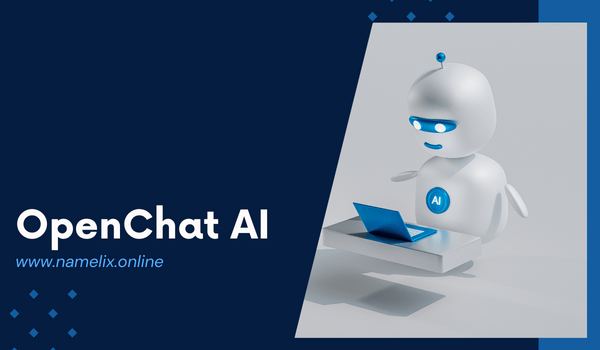
What is OpenChat AI?
OpenChat AI is a comprehensive platform that empowers users to create and deploy custom chatbots tailored to their specific needs. It leverages advanced natural language processing (NLP) and machine learning technologies to enable intelligent conversations between humans and virtual assistants.
At its core, OpenChat AI provides a user-friendly interface where you can design and train your chatbot’s conversational flow.
This involves defining intents (user goals), entities (key information), and responses based on the chatbot’s interpretation of user input. The platform’s powerful NLP algorithms analyze the user’s messages, extract valuable information, and generate appropriate responses in real time.
OpenChat AI boosts your chatbot with multi-language support and integrates with various platforms like websites, apps, and social media. It connects with external APIs and databases, enhancing the chatbot’s ability to deliver precise, context-aware responses.
Additionally, OpenChat AI offers robust analytics and reporting tools. These help you monitor performance, track user interactions, and gather insights for ongoing improvement. Its scalable architecture supports high conversation volumes, making it ideal for any business size.
How Does OpenChat AI Work?
OpenChat AI leverages advanced natural language processing (NLP) and machine learning techniques to enable intelligent conversations between users and chatbots. Here’s a high-level overview of how it works:
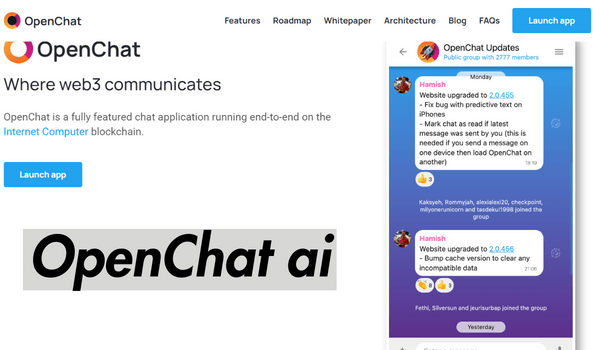
- User Input: A user interacts with the chatbot by sending a message through a supported messaging channel (e.g., website, mobile app, social media).
- NLP Processing: OpenChat AI’s NLP engine analyzes the user’s message, breaking it down into its constituent parts, such as intents (what the user wants to achieve) and entities (relevant pieces of information).
- Intent and Entity Recognition: The NLP engine matches the user’s input against the predefined intents and entities in the chatbot’s knowledge base. This process helps the chatbot understand the user’s intent and extract relevant information from the message.
- Context Awareness: OpenChat AI uses the context of the conversation, including previous messages and stored user data, to give more relevant and personalized responses.
- Response Generation: Based on the identified intent, extracted entities, and contextual information, the chatbot retrieves the appropriate response from its knowledge base or generates a dynamic response using natural language generation techniques.
- Response Delivery: The generated response is sent back to the user through the same messaging channel they used to initiate the conversation.
- Continuous Learning: OpenChat AI can be trained and improved over time by analyzing user interactions, adjusting the knowledge base, and fine-tuning the NLP models for better performance.
How to Create a Custom Chatbot using OpenChat
- Sign Up and Create a New Bot: Start by signing up for an OpenChat AI account and creating a new bot project from the dashboard.
- Design the Conversational Flow: Define the intents (user goals) and entities (key information) your chatbot should recognize. You can either create these from scratch or import pre-built templates for common use cases.
- Train the Chatbot: Provide sample conversations and utterances (user inputs) for each intent and entity. OpenChat AI’s machine learning algorithms will learn from these examples to understand and respond to user inputs accurately.
- Configure Responses: Craft the responses your chatbot will provide for each identified intent and entity combination. You can use static responses or leverage OpenChat AI’s natural language generation capabilities to create dynamic responses.
- Integrate with Messaging Channels: Connect your chatbot to various messaging channels, such as websites, mobile apps, or social media platforms, where users can interact with it.
- Test and Refine: Test your chatbot by stimulating conversations and monitoring its performance. Use the analytics and reporting tools provided by OpenChat AI to identify areas for improvement and fine-tune your chatbot’s knowledge base and responses.
- Deploy and Monitor: Once you’re satisfied with your chatbot’s performance, deploy it to your chosen messaging channels and monitor its interactions with real users. Continuously gather feedback and update your chatbot to enhance its capabilities.
OpenChat AI provides a user-friendly interface and comprehensive documentation to guide you through each step of this process, making it accessible to users with varying technical backgrounds.
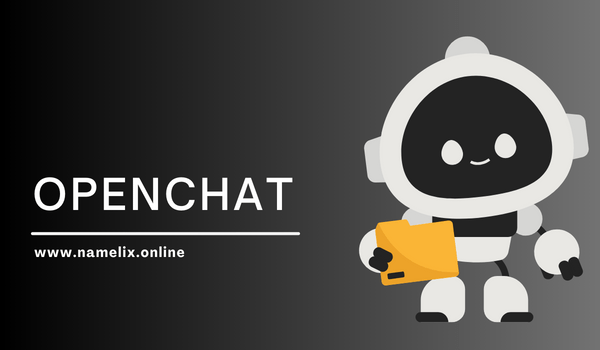
How to Install a Self-Hosted Version of OpenChat
If you prefer to host OpenChat AI on your servers or infrastructure, you can install a self-hosted version of the platform. Here’s a general overview of the steps involved:
- System Requirements: Check that your server meets OpenChat AI’s minimum requirements, including compatible operating systems, hardware specs, and software dependencies.
- Download the Software: Obtain the latest version of the OpenChat AI self-hosted software from the official website or repository.
- Install Dependencies: Install all necessary dependencies or third-party software listed in the documentation, such as databases, web servers, or runtime environments.
- Configure the Installation: To set up the OpenChat AI installation, follow the instructions. Configure network settings, database connections, and system or API integrations as needed. Please use English.
- Initialize the Platform: Run the necessary commands or scripts to initialize the OpenChat AI platform and set up the initial configuration, including admin accounts and basic settings.
- Import or Create Chatbots: Import any existing chatbot configurations or create new chatbots from scratch using the self-hosted OpenChat AI interface.
- Configure Messaging Channels: Set up the desired messaging channels (e.g., websites, mobile apps, social media) and integrate them with your self-hosted OpenChat AI instance.
- Deploy and Monitor: Deploy your self-hosted OpenChat AI platform and monitor its performance, logs, and user interactions to ensure smooth operation and make any necessary adjustments.
It’s important to note that self-hosting OpenChat AI may require additional technical expertise and resources compared to using the hosted version. Refer to the official documentation and support channels for detailed installation instructions and guidance specific to your environment.
Use Cases of OpenChat AI
OpenChat AI is a versatile platform that can be leveraged across various industries and scenarios. Here are some common use cases for OpenChat AI:
- Customer Support: Create intelligent chatbots to manage customer inquiries, provide product details, and offer personalized support. This reduces human team workload and boosts customer satisfaction.
- E-commerce and Sales: Integrate chatbots into online stores to help with product recommendations, order placement, and tracking. This can boost sales and conversion rates.
- Healthcare: Develop chatbots to assist with medical queries, schedule appointments, triage symptoms, and provide reliable health information, thereby improving accessibility and efficiency in healthcare services.
- Education: Implement chatbots as virtual tutors or study assistants, answering students’ queries, providing personalized learning experiences, and facilitating educational resources.
- Banking and Finance: Deploy chatbots to handle routine banking inquiries, assist with account management, provide financial advice, and guide users through complex processes like loan applications or investment decisions.
- Human Resources: Leverage chatbots for employee onboarding, answering HR-related queries, scheduling interviews, and facilitating internal communication and collaboration.
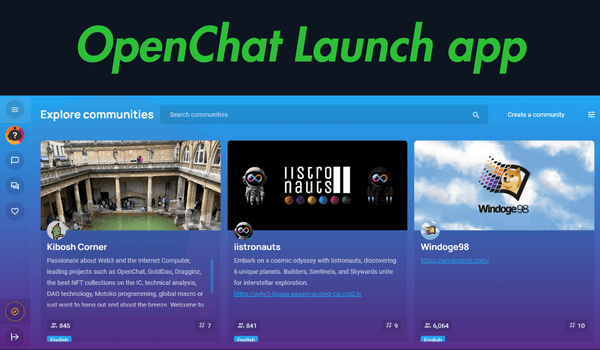
OpenChat AI Features
It is packed with a wide range of features designed to enhance the chatbot creation and management experience. Here are some of the key features offered by the platform:
- Natural Language Processing (NLP): OpenChat AI utilizes advanced NLP algorithms to accurately understand and interpret user inputs, enabling natural and contextual conversations.
- Intent and Entity Recognition: The platform allows you to define intents (user goals) and entities (relevant information) that your chatbot can recognize, enabling it to provide accurate and relevant responses.
- Conversational Flow Design: You can visually design and manage the conversational flow of your chatbot, creating branching paths and conditional responses based on user inputs and contextual information.
- Knowledge Base Management: OpenChat AI provides tools to build and manage a comprehensive knowledge base for your chatbot, allowing you to store and organize relevant information, FAQs, and responses.
- Multi-Language Support: The platform supports multiple languages, enabling you to create and deploy chatbots that can communicate with users in their preferred languages.
- Integrations: OpenChat AI offers seamless integration with various messaging platforms, such as websites, mobile apps, social media channels, and communication tools, allowing you to deploy your chatbot across multiple touchpoints.
- Web and Mobile SDKs: OpenChat AI provides software development kits (SDKs) for web and mobile platforms, enabling developers to easily integrate chatbots into their applications and websites.
- Analytics and Reporting: The platform offers detailed analytics and reporting capabilities, allowing you to track user interactions, monitor chatbot performance, and gain valuable insights for continuous improvement.
These features, along with OpenChat AI’s user-friendly interface and comprehensive documentation, empower users to create intelligent and engaging chatbots tailored to their specific needs.
OpenChat AI Pricing
OpenChat AI offers various pricing plans to accommodate businesses and individuals with different requirements and budgets. Here’s an overview of the pricing structure:
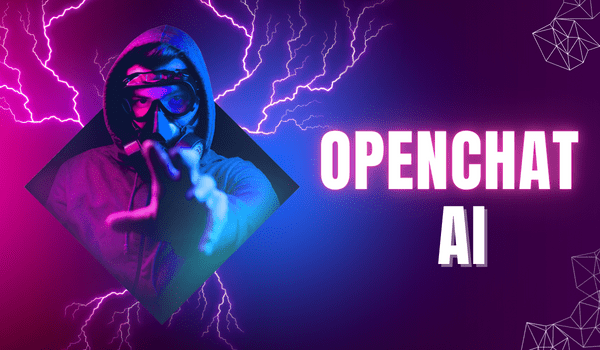
- Free Plan: OpenChat AI provides a free plan for users who want to explore the platform and its features. The free plan includes basic functionalities and limited resources, making it suitable for testing and small-scale projects.
- Starter Plan: The Starter Plan is designed for individuals and small businesses. It offers a range of features, including natural language processing, intent recognition, and basic integrations. This plan comes with a monthly or annual subscription fee.
- Professional Plan: The Professional Plan is tailored for businesses and enterprises with more advanced chatbot needs. It includes additional features like advanced analytics, sentiment analysis, multi-language support, and priority support. The pricing for this plan varies based on the number of users, conversations, and additional resources required.
- Enterprise Plan: The Enterprise Plan is designed for large organizations with complex chatbot requirements and high-volume usage. It offers customized solutions, dedicated support, and advanced features like natural language generation, custom model training, and enterprise-level integrations. The pricing for this plan is typically negotiated based on the specific needs and scale of the organization.
Limitations of OpenChat AI
While OpenChat AI is a powerful and versatile platform for creating chatbots, it’s important to understand its limitations to manage expectations and ensure effective implementation. Here are some potential limitations of OpenChat AI:
- Training Data Quality: The performance of OpenChat AI’s natural language processing (NLP) models heavily relies on the quality and quantity of training data provided. Insufficient or biased training data can lead to inaccurate predictions or biased responses from the chatbot.
- Context Understanding: While OpenChat AI strives to understand and maintain conversational context, its ability to comprehend complex or ambiguous contexts may be limited, potentially resulting in irrelevant or confusing responses.
- Domain Specificity: OpenChat AI may excel in certain domains or use cases but may struggle with highly specialized or niche topics that require deep subject matter expertise or domain-specific knowledge.
- Scalability and Performance: As the number of users and conversations increases, OpenChat AI’s performance and response times may degrade if not properly scaled or optimized for high-volume usage.
- Integration Complexity: Integrating OpenChat AI with third-party systems, APIs, or databases can be complex and may require additional development effort, potentially increasing the overall implementation and maintenance costs.
- Natural Language Limitations: While OpenChat AI aims to provide natural and human-like conversations, its responses may still exhibit limitations in understanding nuanced language, sarcasm, idioms, or cultural references.
- Privacy and Security Concerns: Depending on the use case and data handled by the chatbot, there may be privacy and security concerns related to data storage, transmission, and potential misuse or exploitation of user information.
- Continuous Maintenance and Updates: To maintain the chatbot’s accuracy and relevance, regular maintenance, updates, and retraining may be required, which can be time-consuming and resource-intensive.
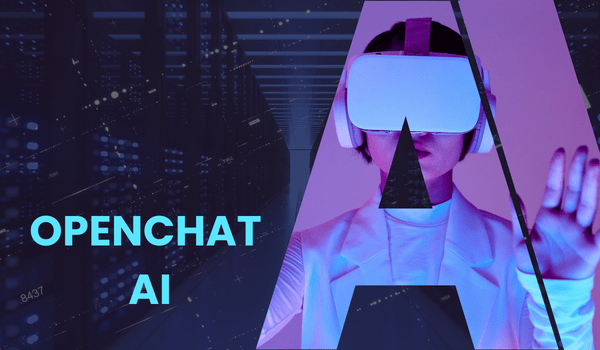
Pros and Cons of OpenChat AI
Like any technology, OpenChat AI has its advantages and disadvantages. Here are some pros and cons to consider:
Pros:
- User-friendly interface for creating and managing chatbots
- Advanced natural language processing (NLP) capabilities
- Support for multiple languages and messaging channels
- Detailed analytics and reporting for performance monitoring
- Scalable architecture to handle high volumes of conversations
- Continuous learning and improvement through machine learning
- Integration with external APIs and databases
- Collaboration and version control features
Cons:
- Potential accuracy limitations due to the quality of training data
- Context understanding may be limited in complex scenarios
- Performance and response times may degrade with high usage
- Integration complexity with third-party systems
- Natural language limitations (idioms, sarcasm, cultural references)
- Privacy and security concerns with user data handling
- Continuous maintenance and retraining requirements
- Potential biases or ethical concerns with AI systems
It’s essential to carefully evaluate your specific requirements, resources, and constraints to determine if the pros of OpenChat AI outweigh the potential cons for your use case.
OpenChat AI Login and Sign Up
To get started with OpenChat AI, you’ll need to create an account and log in to the platform. Here’s a step-by-step guide to the login and sign-up process:
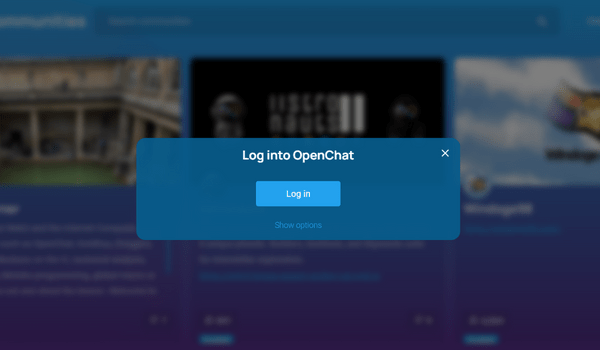
Sign Up:
- Visit the OpenChat AI website (e.g., https://openchat.ai) and click on the “Sign Up” button or link.
- Choose whether you want to sign up as an individual or a business.
- Fill out the registration form with your personal or business details, such as name, email address, and password.
- Agree to the terms and conditions and privacy policy.
- Complete any additional verification steps, such as confirming your email address or providing further information.
- Once your account is created, you’ll receive a confirmation email and can proceed to log in.
Log In:
- Visit the OpenChat AI website and click on the “Log In” button or link.
- Enter the email address and password you used during the sign-up process.
- If you have enabled two-factor authentication, enter the verification code sent to your registered device.
- Click the “Log In” button to access your OpenChat AI account dashboard.
After logging in, you can access OpenChat AI’s features. These include creating and managing chatbots, configuring settings, and monitoring analytics.
If you encounter any issues during the login or sign-up process, OpenChat AI’s support team can assist you. Additionally, make sure to follow best practices for account security, such as using strong passwords and enabling two-factor authentication.
Alternatives for OpenChat AI
- Dialogflow (Google Cloud): Dialogflow is a natural language processing platform developed by Google that allows you to build conversational interfaces for websites, mobile apps, and IoT devices. It offers advanced features like multi-language support, integration with Google’s machine learning capabilities, and built-in analytics.
- Amazon Lex: Amazon Lex, provided by Amazon Web Services (AWS), allows developers to create conversational interfaces with voice or text. It uses AWS’s natural language understanding and automatic speech recognition technologies, ideal for developing chatbots, virtual assistants, and similar applications.
- IBM Watson Assistant: IBM Watson Assistant is a cloud-based conversational AI service that allows you to create intelligent virtual agents capable of understanding natural language and providing contextual responses. It offers features like intent recognition, entity extraction, dialog management, and integration with IBM’s broader AI capabilities.
- Microsoft Bot Framework: The Microsoft Bot Framework is a comprehensive platform for building and deploying conversational AI solutions. It offers tools and services for creating chatbots, virtual assistants, and other conversational experiences across various channels, including websites, messaging apps, and virtual assistants like Cortana.
- Rasa: Rasa is an open-source conversational AI platform that enables developers to build and deploy contextual AI assistants. It uses machine learning algorithms and natural language processing techniques to understand user inputs and provide relevant responses. Rasa offers flexibility and customization options, making it suitable for a wide range of use cases.
- Plannit AI: Plannit AI uses AI to create business plans in minutes. Answer questions, and get a tailored 15-20 page plan & resources to launch your dream.
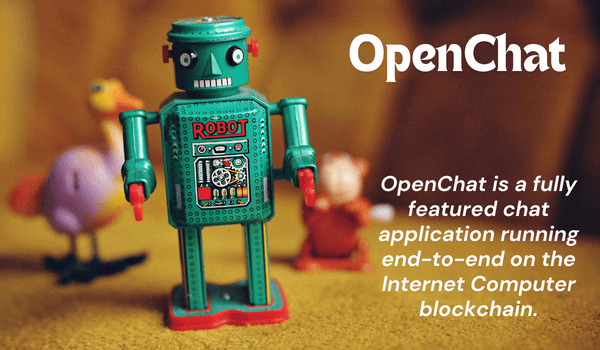
Each of these alternatives has its strengths, features, and pricing structures. It’s important to evaluate your specific requirements, such as the level of customization needed, integration capabilities, scalability, and pricing, to determine the most suitable option for your chatbot development needs.
FAQs
OpenChat AI provides a user-friendly interface that doesn’t require extensive programming knowledge. However, familiarity with basic programming concepts and natural language processing (NLP) principles can be beneficial. Advanced customization or integration may require additional technical skills.
Yes, OpenChat AI offers integration capabilities with various external systems and APIs. This allows you to connect your chatbot with databases, CRM systems, payment gateways, and other third-party services to enhance its functionality and access relevant data.
OpenChat AI takes data privacy and security seriously. It implements industry-standard security measures, such as encryption, access controls, and secure data storage. However, it’s important to review OpenChat AI’s privacy policies and ensure compliance with relevant data protection regulations for your specific use case.
Yes, OpenChat AI supports multiple languages, allowing you to create chatbots that can communicate with users in their preferred languages. The platform provides tools for language detection, translation, and training chatbots with multilingual data.
OpenChat AI offers various pricing plans, including a free plan for basic usage, as well as paid plans with additional features and resources. Pricing is typically based on factors such as the number of conversations, integrations, and additional services required. OpenChat AI also provides custom pricing options for enterprises with specific needs.
Conclusion
Stop missing out on valuable customer connections. OpenChat AI empowers you to build the perfect AI assistant, tailored to your specific needs. Imagine a tireless, knowledgeable virtual companion that engages your audience, answers questions instantly, and streamlines everyday tasks. OpenChat AI makes it easy.
No coding expertise is required. Upload your training data, define your chatbot’s personality, and watch it come to life. Boost lead generation, improve customer satisfaction, and elevate your brand image. OpenChat AI’s intuitive platform empowers you to unlock the true potential of conversational AI.
Don’t just dream about a better customer experience – create it. Take the first step towards AI-powered success with OpenChat AI today!
